From Shangsi Festival to Sanyuesan Festival, the Feast Has Lasted for Thousands of Years
Publication time:2023-05-24 16:54:58
Written by Lin Han / Translated by Tang Yi
Sanyuesan Festival, which falls on the third day of the third lunar month, is the Zhuang people’s festival included in the fourth batch of representative items of National Intangible Cultural Heritage by the State Council of China on November 11, 2014. That year, the government of Guangxi Zhuang Autonomous Region identified “Sanyuesan” as a traditional ethnic custom festival, and people in the autonomous region got a 2-day holiday. From then on, the WeChat movements posted by people in Guangxi have won the envy of those outside that region.
However, the Sanyuesan Festival does not belong to the Zhuang people alone; it belongs to the Chinese nation. As early as 3,000 years ago, during the Shang and Zhou dynasties, the Sanyuesan Festival began to take shape and became known as the Shangsi Festival, which lasted for thousands of years in the central plains of China, with ethnic minorities in southwest China being the most affected. Today, besides the Zhuang people, other ethnic groups such as Dong, Miao, and Yao also celebrate the festival with songs, dances, and special activities.
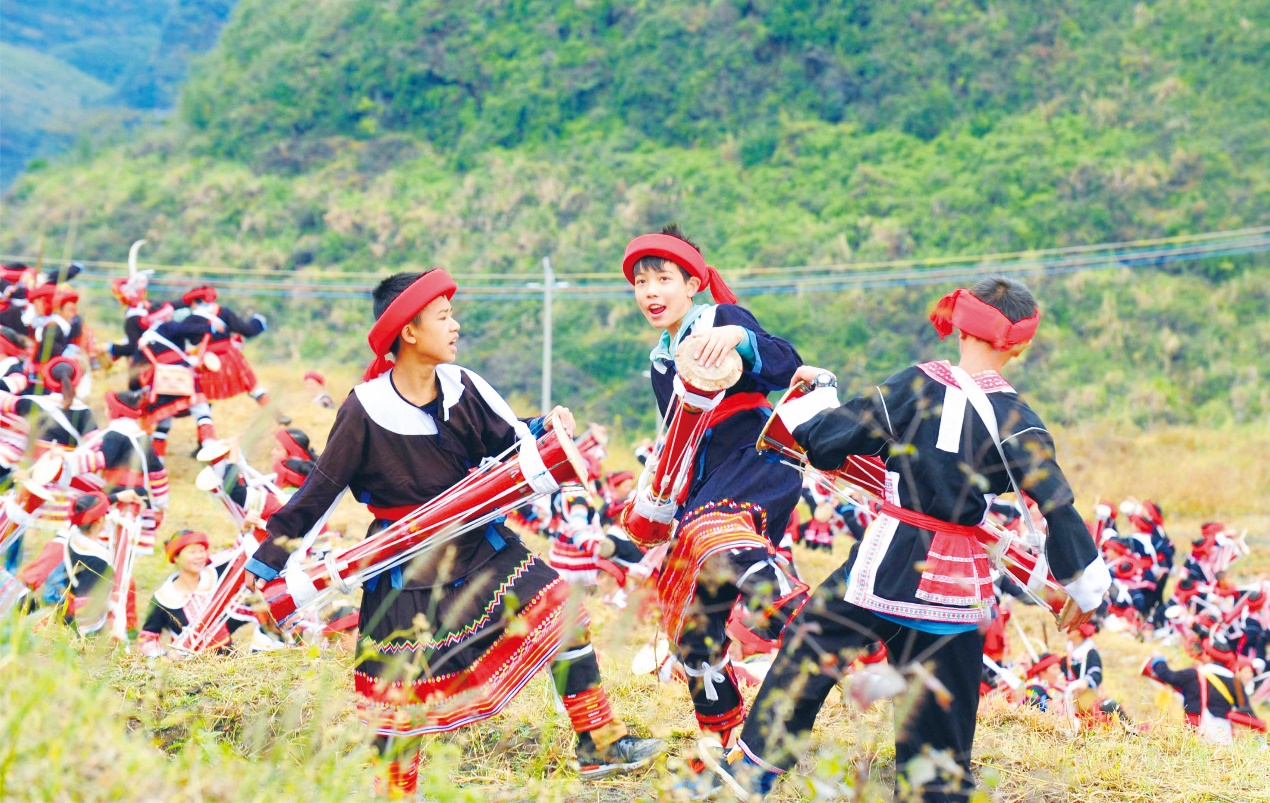
The folk songs of Zhuang lasted for thousands of years that heal your heart
Liu Sanjie (Third Sister in the Liu Family), the song fairy, is well-known among the Zhuang people. She is represented as a classic Zhuang singer and a legendary figure who expressed the ideals and aspirations of the laboring people with sweet songs and was beloved by the people. Liu Sanjie is said to have composed many melodic and moving folk songs for the people, which have been handed down in the Zhuang region and sung by the Zhuang people until now.
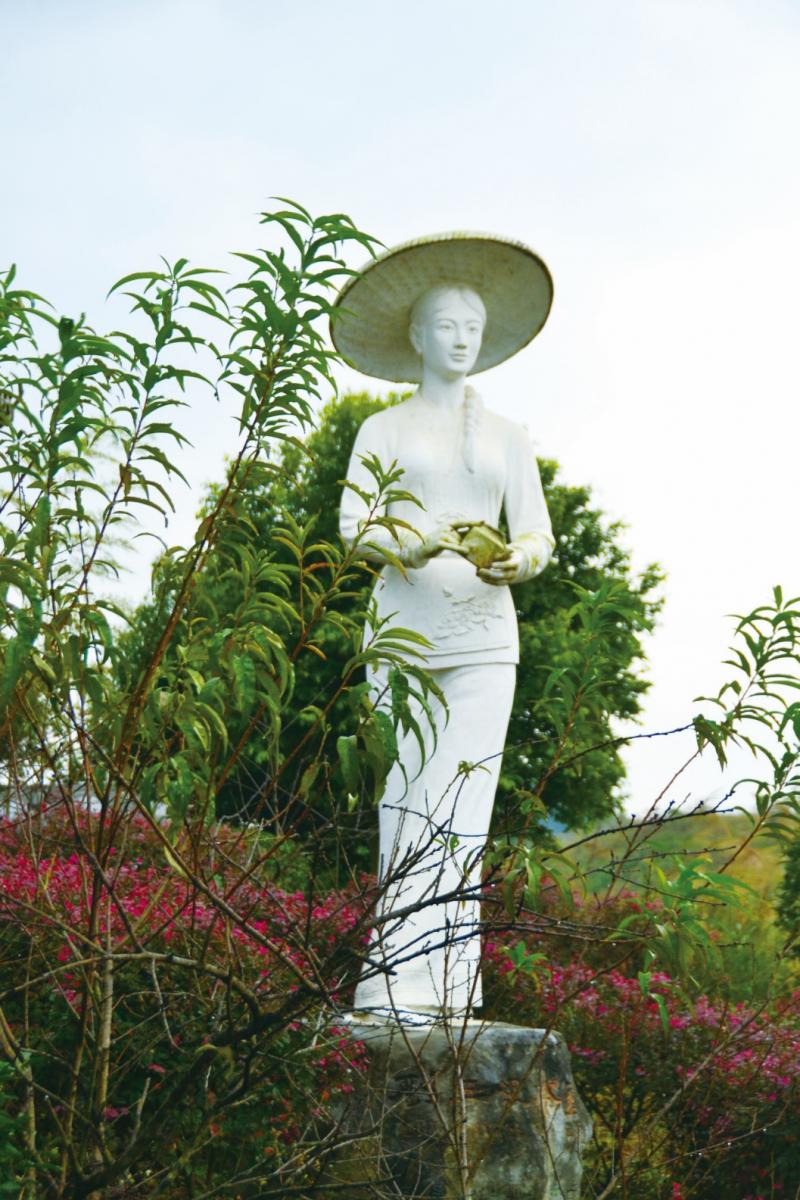
It was a Caidiao opera that made Liu Sanjie known to the people. On February 1, 1960, the front page of Guangxi Daily carried a report titled “Party Committee of the Guangxi Autonomous Region Decides to Hold a Joint Performance of Third Sister Liu in March.” Soon, the drama went viral in Guangxi. The government then sent the cast to Beijing, where they presented the show to the central leadership and the people of the whole country. It was also the year that the musical drama Third Sister Liu took off in China, performing a record number of nearly 600 times in a year, making it the biggest hit in Chinese theater history.
Inspired by the musical drama, a film also dubbed Third Sister Liu enjoying a good reputation both at home and abroad later was prepared to shoot. Soon after its release in 1961, the film, starring Huang Wanqiu and sung by Fu Jinhua with gorgeous Chinese landscapes and beautiful folk songs, achieved cult status in China. Sister Liu’s sweet voice, which echoes bravery against bullies and the pursuit of freedom, traversed the green mountains and clean water of Guangxi and was presented on the stage of China and the world.
In Zhuang folk songs, there are myriads of types. In terms of content, it includes ancient songs, narrative ballads, daily songs, work songs, love songs, children’s folk songs, and songs for current politics and ceremonies. The differences in the environment and traditional customs have given rise to various tunes. For example, the folk songs of different counties in a region have different tunes, and they are mainly sung in an antiphonal manner, namely the loud and high-pitched Liao folk songs, the gentle and indirect Napo folk songs, the triple-voiced folk songs of Nanning Mashan, and the high-pitched folk songs of Chongzuo Daxing.

In 1983, the Guangxi government designated the third day of the third lunar month as the Song Festival of the Zhuang ethnic group. Every year on this day, the sound of folk songs fills the air, and joyful people fill the land of Guangxi. With vivacious songs, Zhuang people sing for their life, for love, and for labor and express their passion for life and the miss for Liu Sanjie.
Dong people celebrate the farming season with songs and dances
Sanjiang County in Guangxi was once the land of Chuyue, where industrious and brave Dong people excelled in singing and dancing and were skilled in manual tasks. They worshipped nature and had a special affection for the “Sanyuesan Festival.”

There is a saying in Dong people that “Farming season to come when the Tung trees blossom.” According to a legend, in the year when Tung trees did not bloom, the farming season was missed, and Dong people had to flee to other places to live. Learning from the past, they decided to visit relatives and friends to remind each other that the time for farming has come on the third day of the third lunar month each year. On that day, they will blow a traditional instrument Lusheng, sing songs, and pray for favorable wind and rain and a good harvest. Such activities have gradually evolved into the custom of the “Sanyuesan Festival” of today’s Dong people.
In general, the Sanyuesan Festival of the Dong ethnic group in Sanjiang lasts for five days from the first day of the third lunar month. Every home and village has exuded an air of happiness from that day on. People will catch fish and shrimp and invite relatives and friends to their houses. The young girls who stand by the limpid stream peeped shyly, waiting for the young men of the hillside to come and ask for a basket to show their admiration towards the girls, accompanied by the special great song sung for their love.
On the third day, the people of Dong village begin singing and dancing while drums and gongs hum in the air. The melody of the Lusheng fills every corner of the village. The center of the village must be the most bustling place where the “beast” roar in the middle of the crowd when three fireworks are let off. With sparks on their tails, they run, and their robust bodies are running with sweat. As long as their horns touch, the crowd will break into rapturous applause that drowns out the surrounding firecrackers. The race is heating up. When the race has a clear winner, the girls of the winning side will cheer and take away the flags of the defeated side and hang a red flag on their “king of the beasts,” representing the glory of the whole village. It is the most exciting activity in Dong Village — a bullfight. According to the legend of the Dong people, the fight between buffaloes inspired their farming and taught them how to transplant rice. To commemorate the event, people went to a bullfight, which had been a tradition ever since. There are also activities such as antiphonal singing, Caitang dance, and firework scramble.
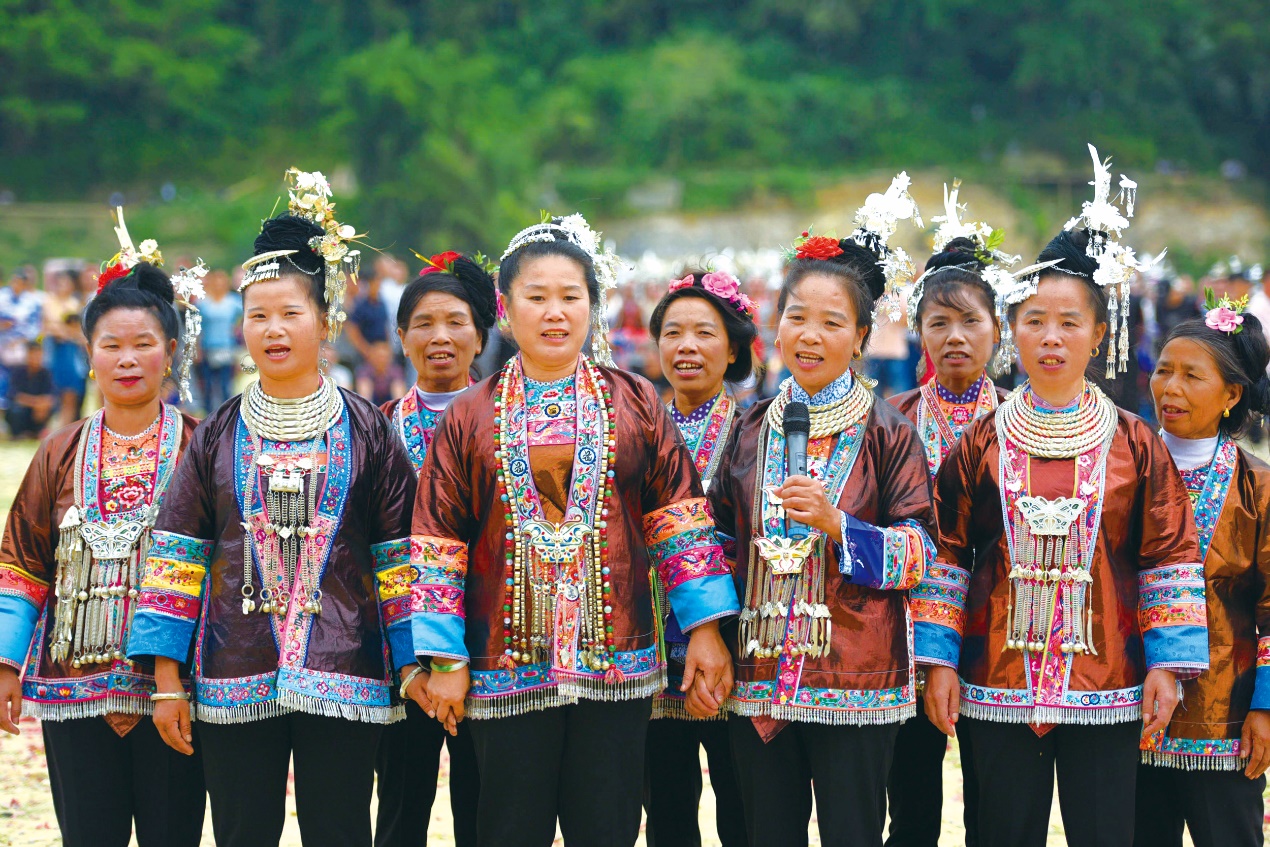
Yao people sing joyfully in memory of Pangu
The Yao people generally live in southwest China, and Guangxi serves as the largest habitat of the Yao people. Sanyuesan Festival is also an important festival for them.
The Sanyuesan Festival of Yao people relates to Pangu, an ancient Chinese deity considered the world’s first living being and creator. The legend said beasts always broke into villages to hurt villagers and destroyed their crops in the past. To protect his homeland, Pangu, the hero of the village, led his warriors up the mountain to hunt and kill the beasts. However, on the way, Pangu’s belly was pierced by an antelope’s horns, and he died on the spot. That sad day was the third day of the third lunar month. Hence, to commemorate the national hero Pangu, the Yao people named his deathday “Ganba Festival.” People will go up to the mountain to hunt beasts, dry the prey, take them back home, and conduct sacrifices to Pangu.
On the day of the Sanyuesan Festival, Yao people will suspend their farm work and rest for one day to pay tribute to Pangu. Women get together and take out their needles and thread to embroider exquisite patterns; some men will recite sutra while others will invite their brothers to down a round of drinks. The unmarried girls and the handsome boys will date in the woods around the village and be occupied with endless whispers of love.
People in Longsheng, Guangxi, will gather to make tea-oil tea and sing folk songs at the Sanyuesan Festival. Their local folk songs include Xu songs, songs for tea, songs for worship, etc. The forms are flexible and diverse, including singing in an antiphonal way, chorus, and teaching. Legend has it that in the past, Yao’s family cultivated the hills to do farm work. They tramped over hills, plowed in spring, and harvested in autumn, and their backs are bent due to fatigue. The celestial gods were very sympathetic to farmers’ hardship and were moved by their spirit of diligence, so they dressed up as passing merchants to help the Yao people by tying a hemp rope on the Yao people’s poles and baskets. Then the heavy burden became light, and they asked them to sit down and rest and taught them to sing folk songs. It happened to be the third day of the third lunar month, so the Yao family later made this day a traditional song festival to thank the gods for their help.
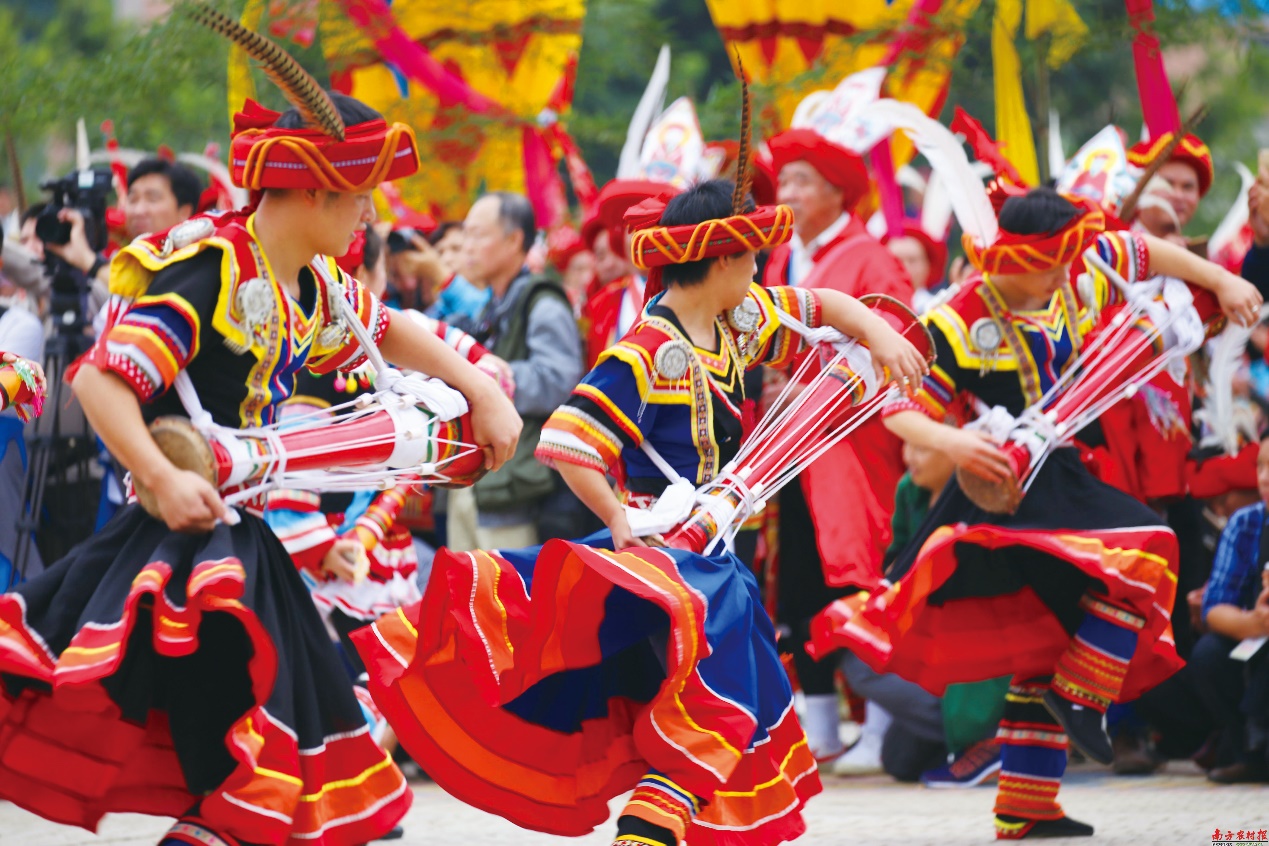
Miao People, horse-fight for love
In Rongshui Miao Autonomous County, Guangxi, there is a saying that “people ride horses for pleasure and race horses for love.” Unlike beast fighting in other regions, horse fighting in the Miao people of Rongshui is not just for entertainment but for marriage adjudication. In the past, if several teenagers fell in love with the same girl at the same time and the girl did not know who to choose as her mate, the king of Miao would organize a horse fight. Finally, the girl would marry the one whose horse won the competition.
As time passed, the rule of “marriage adjudication” of the horse fighting of the Miao people in Rongshui faded. The activity then became a mass festival entertainment competition. Nowadays, the horse fight, full of ethnic style, serves as an integral part of the traditional Miao festival as well as in the Sanyuesan Festival.
On that day, the ring will be crowded and full of people. With the master’s traction, two stallions step into the field. When they look at each other for a moment, the tension in the whole ring immediately lights up, and people are singing in full cry. The horses weave, step, run, and approach each other! They bump against and bite each other! The two stallions grow braver on the field as the cries grow louder — endurance, kicking, fighting, frustration, defeat, resistance, and fall. Finally, one of the horses can not defend itself and kneel on its front leg. It begins to retreat and escape from the ring. After the fights, the last to stay in the field will emerge as the “King of Horse” in the phase.
The song and dance of the Miao people are what you should not miss at the Sanyuesan Festival. Besides the green mountains and clean water, Miao girls and boys will dress in colorful costumes with rustling silver and dance briskly. They sing for mountains and rivers, for love, or for commemorating their ancestors. The lively scene attracts people to join in and have a taste of the charm of the Sanyuesan Festival.
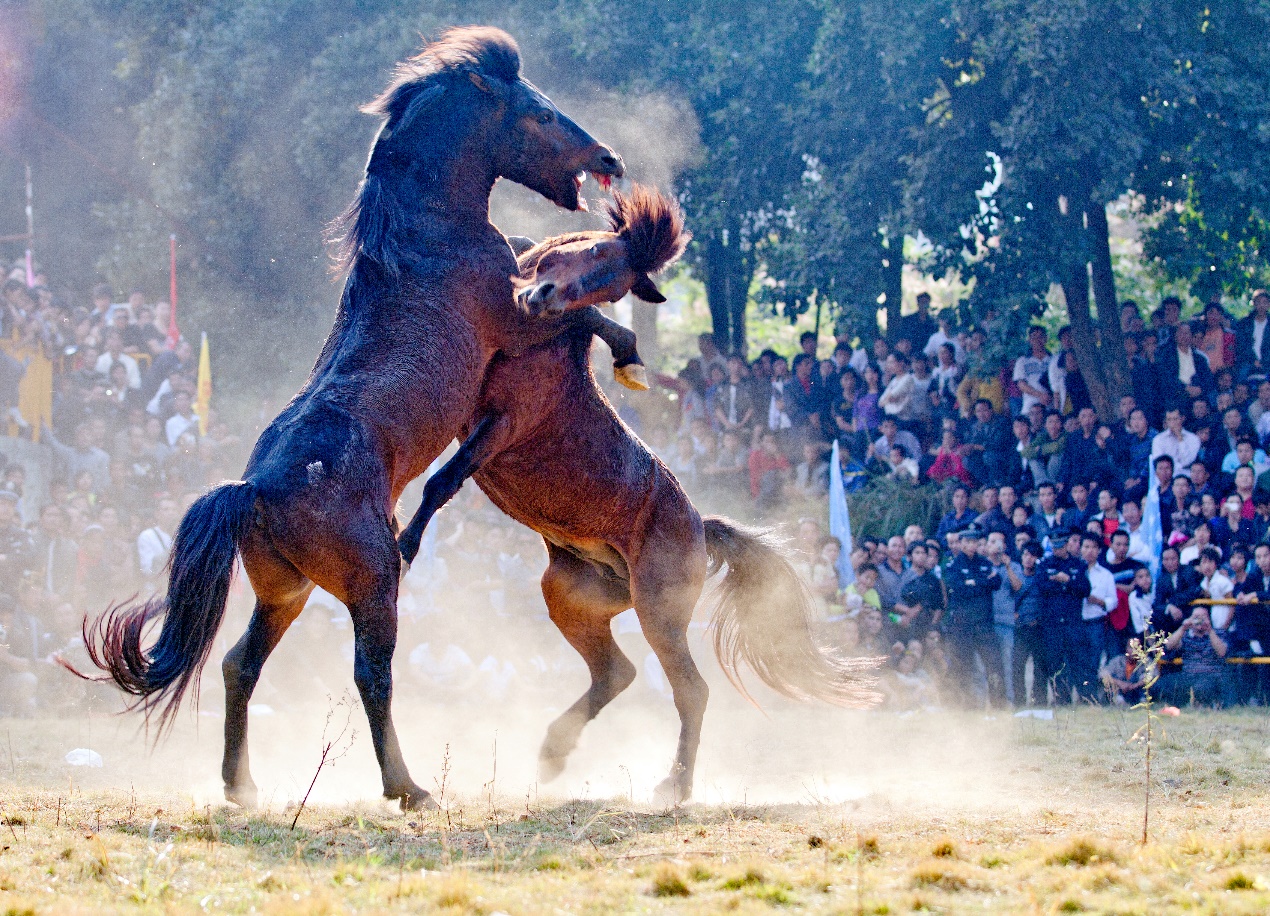
Horse fight in Rongshui County in Sanyuesan (Source: The Publicity Department of the Party Committee of Rongshui)

